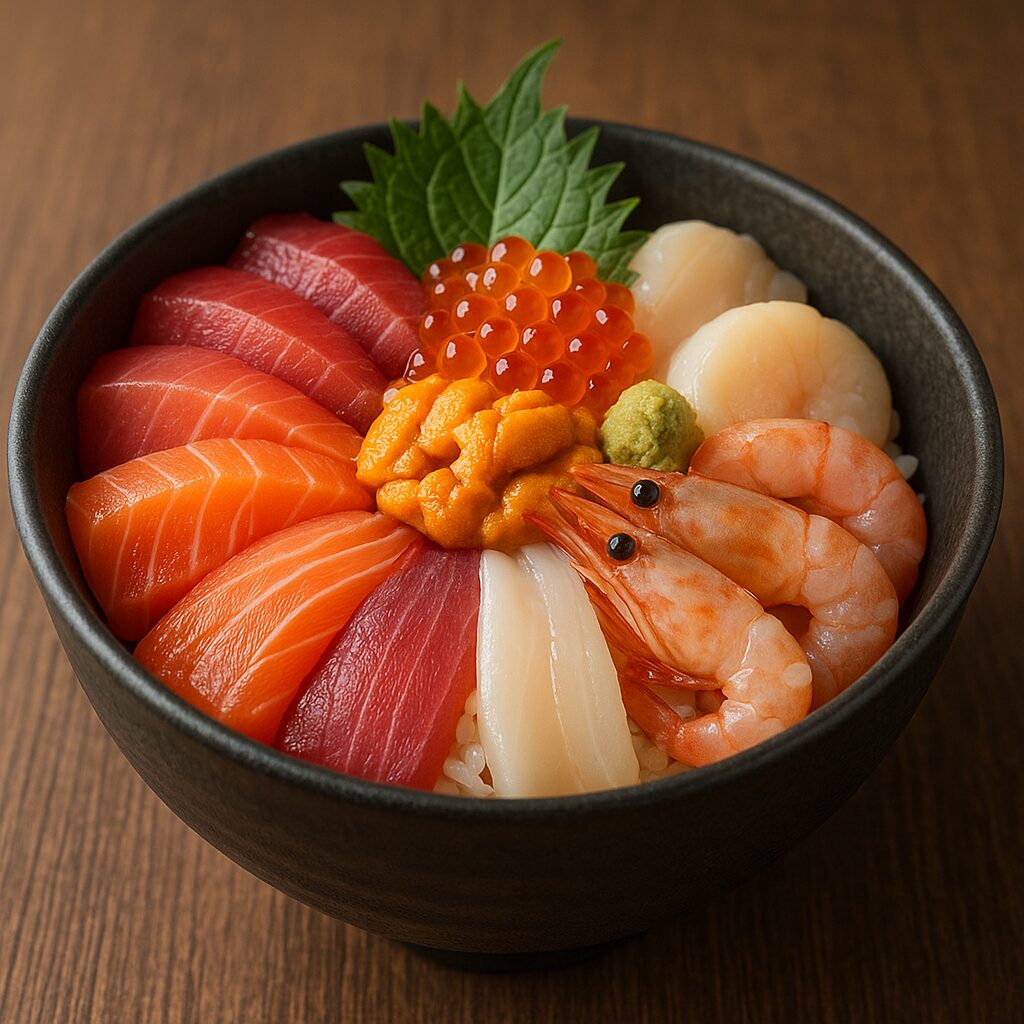特徴
新鮮な魚介類
北海道は寒流と暖流が交わる漁場に恵まれており、イクラ・ウニ・カニ・ホタテ・サーモン・甘エビなど、多種多様な海鮮を使います。
豪華さ
複数種類の海鮮を一度に味わえる「盛り合わせ型」が多く、観光地や市場では色鮮やかに盛られます。
丼文化
寿司より手軽に、多様な具材を一度に楽しめる点が魅力。酢飯や白飯の上に豪快に盛り付けるスタイル。
地域性
小樽はイクラ、函館はイカ、釧路はサンマやカニ、利尻・礼文はウニなど、産地ごとに特色が出ます。
材料(2人分)
- ご飯(酢飯でも白飯でも可) … 400g
- サーモン(刺身用) … 100g
- マグロ赤身 … 100g
- ホタテ … 2個
- イクラ … 50g
- 甘エビ … 4尾
- ウニ … 50g
- 大葉・刻み海苔・わさび … 適量
- 醤油 … 適量
味が薄めの刺し身の場合は酢飯の甘みを少し強くすると美味しくなります。
作り方
- ご飯を丼によそい、刻み海苔や大葉を敷く。
- 刺身を食べやすい大きさに切り、彩りよく盛り付ける。
- イクラやウニを中央にトッピング。
- わさび醤油をかけていただく。
(※季節や場所によってはカニ、イカ、ツブ貝なども入る)
栄養価(目安:1人分 約600g)
※魚介の盛り合わせによって変動あり
- エネルギー:約650〜750 kcal
- たんぱく質:35〜45 g(魚介類のアミノ酸バランスは非常に良い)
- 脂質:15〜20 g(特にサーモンやウニから良質な脂質)
- 炭水化物:80〜90 g(ご飯)
- ビタミン類:B群、ビタミンD、ビタミンEが豊富
- ミネラル:亜鉛・鉄・マグネシウム・ヨウ素
- オメガ3脂肪酸(EPA・DHA):血流改善、動脈硬化予防に寄与
北海道海鮮丼の歴史
起源
江戸期の漁師まかないに由来。漁港で獲れたてを飯にのせて食べる習慣が発展。
観光料理化
戦後〜昭和30年代に市場食堂で観光客向けに提供され、「北海道観光名物」として定着した。
地域色
小樽・函館はイクラ・ウニ、釧路・根室はカニ・サンマ、稚内・利尻はバフンウニなど、各地で特色ある丼が誕生。
現代
観光客向けの豪華丼から地元向けのリーズナブルな丼まで幅広く展開し、北海道を代表する食文化となっている。
English translation
Features of Hokkaido Seafood Donburi
Fresh Seafood
Hokkaido benefits from rich fishing grounds where cold and warm currents meet, offering a wide variety of seafood such as salmon roe, sea urchin, crab, scallops, salmon, and sweet shrimp.
Luxury
It often features an assortment of multiple seafood items at once, creating a colorful and visually appealing bowl commonly found at markets and tourist spots.
Donburi Culture
Compared to sushi, it is a more casual way to enjoy a variety of toppings. Fresh seafood is generously served over vinegared rice or plain white rice.
Regional Characteristics
Otaru is famous for salmon roe, Hakodate for squid, Kushiro for saury and crab, while Rishiri and Rebun specialize in sea urchin. Each area highlights its local specialty.
Basic Recipe (Example: Hokkaido Market Style Seafood Donburi)
Ingredients (for 2 servings):
- Rice (vinegared or plain) … 400g
- Salmon (sashimi grade) … 100g
- Tuna (red meat) … 100g
- Scallops … 2 pieces
- Salmon roe … 50g
- Sweet shrimp … 4 pieces
- Sea urchin … 50g
- Shiso leaves, shredded nori, wasabi … as needed
- Soy sauce … as needed
Instructions:
- Place rice in bowls and sprinkle with shredded nori and shiso leaves.
- Cut sashimi into bite-sized pieces and arrange them beautifully on the rice.
- Add salmon roe and sea urchin in the center as toppings.
- Serve with soy sauce and wasabi.
(Seasonally, crab, squid, whelk, or other seafood may also be added.)
Nutritional Value (per serving, approx. 600g)
- Calories: 650–750 kcal
- Protein: 35–45 g (excellent amino acid balance from seafood)
- Fat: 15–20 g (rich in high-quality fats from salmon and sea urchin)
- Carbohydrates: 80–90 g (from rice)
- Vitamins: Rich in B vitamins, vitamin D, and vitamin E
- Minerals: Zinc, iron, magnesium, iodine
- Omega-3 fatty acids (EPA/DHA): Help improve blood circulation and prevent arteriosclerosis
👉 Overall, it is high in protein, low in saturated fat, and rich in minerals, making it very healthy. However, salmon roe and sea urchin contain relatively high levels of purines, salt, and cholesterol, so excessive intake should be avoided.
Historical Background
Origin
It dates back to the Edo period, when fishermen ate freshly caught seafood placed on rice as a simple meal. In Hokkaido, this practice developed into a local tradition.
Tourism Cuisine
From the post-war era to the 1950s, seafood bowls began being served in market eateries for tourists, becoming established as a specialty of Hokkaido.
Regional Styles
Otaru and Hakodate are known for salmon roe and sea urchin bowls, Kushiro and Nemuro for crab and saury, and Wakkanai and Rishiri for premium sea urchin varieties.
Modern Times
Today, seafood donburi ranges from luxurious bowls for tourists to affordable everyday meals for locals, firmly establishing itself as one of Hokkaido’s representative food cultures.


何でも質問してください!